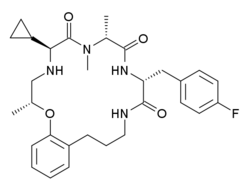Chemistry:Ulimorelin
 | |
| Clinical data | |
|---|---|
| ATC code |
|
| Identifiers | |
| |
| CAS Number | |
| PubChem CID | |
| ChemSpider | |
| UNII | |
| KEGG | |
| Chemical and physical data | |
| Formula | C30H39FN4O4 |
| Molar mass | 538.664 g·mol−1 |
| 3D model (JSmol) | |
| |
| |
Ulimorelin (INN, USAN) (developmental code name TZP-101) is a drug with a modified cyclic peptide structure which acts as a selective agonist of the ghrelin/growth hormone secretagogue receptor (GHSR-1a).[1] Unlike many related drugs, ulimorelin has little or no effect on growth hormone (GH) release in rats.[2] However, like ghrelin and other ghrelin agonists, ulimorelin does stimulate GH release with concomitant increases in insulin-like growth factor 1 (IGF-1) in humans.[3] It has been researched for enhancing gastrointestinal motility, especially in gastroparesis[4] and in aiding recovery of bowel function following gastrointestinal surgery, where opioid analgesic drugs used for post-operative pain relief may worsen existing constipation.[5][6][7][8] While ulimorelin has been shown to increase both upper and lower gastrointestinal motility in rats,[8] and showed promising results initially in humans,[4][6] it failed in pivotal clinical trials in post operative ileus.[7]
A common side effect of ghrelin is reduced blood pressure. Ulimorelin has been shown to inhibit vasoconstriction of rat arteries in vitro elicited by the α1-adrenoceptors agonists phenylephrine and methoxamine, and to increase artery tension at high concentrations.[9] Effects on blood pressure, however, were not observed in human clinical trials.[4][7]
References
- ↑ "Optimization of the potency and pharmacokinetic properties of a macrocyclic ghrelin receptor agonist (Part I): Development of ulimorelin (TZP-101) from hit to clinic". Journal of Medicinal Chemistry 54 (24): 8305–20. December 2011. doi:10.1021/jm2007062. PMID 22106937.
- ↑ "Pharmacological demarcation of the growth hormone, gut motility and feeding effects of ghrelin using a novel ghrelin receptor agonist". Endocrinology 149 (12): 6280–8. December 2008. doi:10.1210/en.2008-0804. PMID 18719021.
- ↑ "Ghrelin agonist (TZP-101): safety, pharmacokinetics and pharmacodynamic evaluation in healthy volunteers: a phase I, first-in-human study". Journal of Clinical Pharmacology 48 (2): 193–202. February 2008. doi:10.1177/0091270007310380. PMID 18199894.
- ↑ 4.0 4.1 4.2 "Contribution of protein binding to the pharmacokinetics of the ghrelin receptor agonist TZP-101 in healthy volunteers and adults with symptomatic gastroparesis: two randomized, double-blind studies and a binding profile study". Clinical Drug Investigation 29 (6): 409–18. 2009. doi:10.2165/00044011-200929060-00004. PMID 19432500.
- ↑ "The Ghrelin agonist TZP-101 for management of postoperative ileus after partial colectomy: a randomized, dose-ranging, placebo-controlled clinical trial". Diseases of the Colon and Rectum 53 (2): 126–34. February 2010. doi:10.1007/DCR.0b013e3181b54166. PMID 20087086.
- ↑ 6.0 6.1 "Ghrelin as a target for gastrointestinal motility disorders". Peptides 32 (11): 2352–6. November 2011. doi:10.1016/j.peptides.2011.03.014. PMID 21453735.
- ↑ 7.0 7.1 7.2 "Ghrelin agonist TZP-101/ulimorelin accelerates gastrointestinal recovery independently of opioid use and surgery type: covariate analysis of phase 2 data". World Journal of Surgery 36 (1): 39–45. January 2012. doi:10.1007/s00268-011-1335-9. PMID 22072430.
- ↑ 8.0 8.1 "Safety and efficacy of ulimorelin administered postoperatively to accelerate recovery of gastrointestinal motility following partial bowel resection: results of two randomized, placebo-controlled phase 3 trials". Diseases of the Colon and Rectum 56 (7): 888–97. July 2013. doi:10.1097/DCR.0b013e31829196d0. PMID 23739196.
- ↑ "Effect of the ghrelin receptor agonist TZP-101 on colonic transit in a rat model of postoperative ileus". European Journal of Pharmacology 604 (1–3): 132–7. February 2009. doi:10.1016/j.ejphar.2008.12.011. PMID 19121631.
 |

